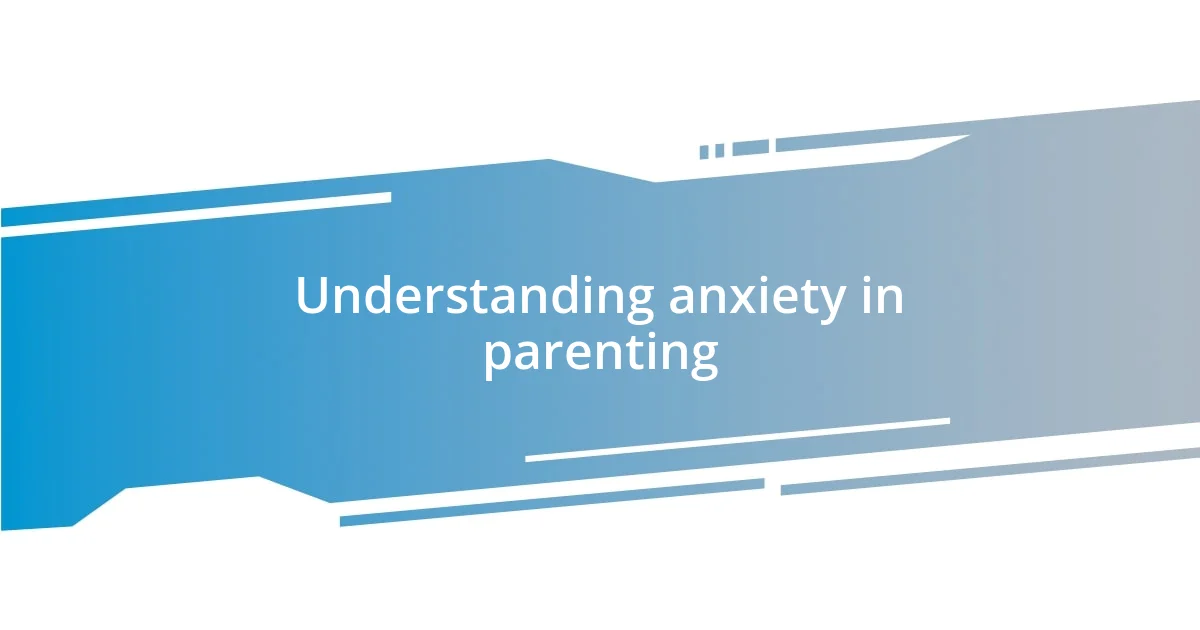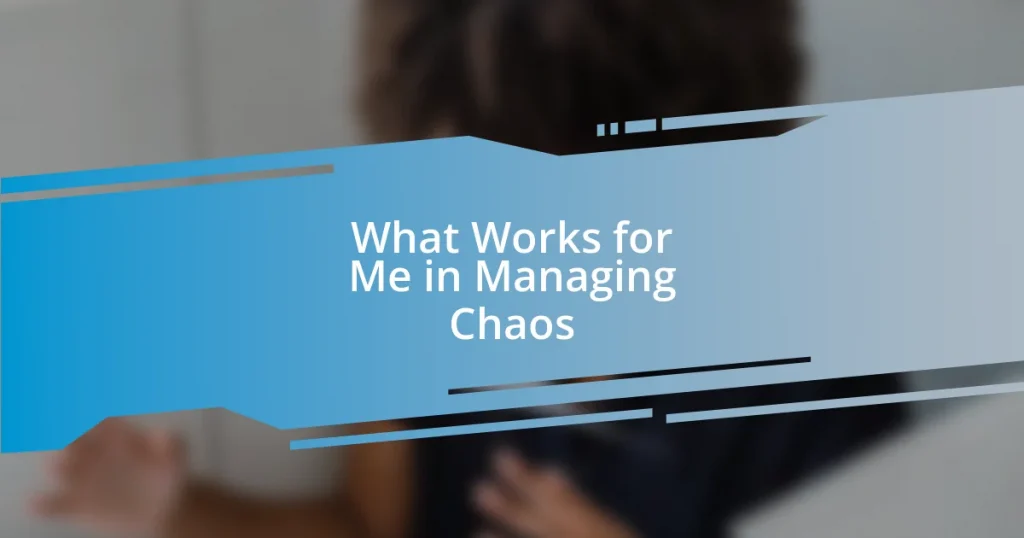Key takeaways:
- Understanding and acknowledging personal anxiety as a parent is crucial for creating a balanced environment and avoiding negative impacts on children.
- Recognizing symptoms of anxiety, such as heightened sensitivity, physical tension, and emotional responses, helps differentiate between normal stress and deeper anxiety that requires addressing.
- Engaging in mindfulness techniques and open communication about anxiety with children fosters trust and emotional validation, making it easier for them to navigate their own feelings.

Understanding anxiety in parenting
Navigating parenting while managing anxiety can feel like walking a tightrope. I vividly remember the anxiety that washed over me during my child’s first day of school. Questions spiraled in my mind: “Will they make friends? What if something happens to them?” It was during moments like these that I discovered that my anxiety didn’t just affect me; it shaped the way I approached parenting.
At times, anxiety manifested as an overwhelming urge to control every situation, whether it was planning a perfect birthday party or monitoring playdates meticulously. Reflecting on those moments, I ask myself: was my need for control a way to shield myself from potential heartache, or was it a tool I used to navigate my fears? I realized that while I was trying to protect my child, I was also missing out on the simple joys of parenting; letting go is just as important as being vigilant.
Sometimes, I felt like I was caught in a cycle of worry and guilt—worrying that my anxiety would impact how my child perceived the world, and guilt for feeling this way in the first place. The journey taught me that understanding my anxiety was crucial; it wasn’t a flaw in my parenting, but rather an emotion I needed to acknowledge and manage. Each step I took toward accepting my feelings became a step toward creating a more balanced environment for my child.

Recognizing anxiety symptoms in parents
Recognizing anxiety symptoms in parents is crucial for both personal well-being and parenting effectiveness. I found that my anxiety often disguised itself within everyday behaviors. For example, I noticed a heightened sensitivity to my child’s accomplishments and failures; a simple stumble led to racing thoughts about their future. That immediate cascade of worry made me realize how deeply my own anxiety played a role in my perceptions of their experiences.
Another telltale sign I encountered was physical tension. I would genuinely feel it in my shoulders and neck, a tightness that seemed anchored in fear—fear of the unknown or the thought of my child facing challenges. This sensation became a red flag for me. When that tension increased, I understood it was time to take a step back and evaluate what was triggering these feelings. Acknowledging this connection allowed me to seek healthier outlets, like talking to friends or practicing deep breathing exercises, which significantly eased those moments.
Lastly, I became aware of my emotional responses during small, seemingly trivial situations. An unexpected change in plans could send me spiraling into anxiety, feeling nearly paralyzed by the thoughts of potential chaos. In looking back, these reactions weren’t just signs of being overwhelmed; they were fundamental indicators of my anxiety. Understanding these symptoms helped me differentiate between normal parenting stress and the deeper, more pervasive anxiety I needed to address.
| Symptom | Indicators |
|---|---|
| Heightened Sensitivity | Overreacting to child’s success or failure |
| Physical Tension | Tightness in shoulders, neck, and jaw |
| Emotional Responses | Paralysis during unexpected changes; feeling overwhelmed |

Coping strategies for anxious parents
Coping with anxiety as a parent can feel overwhelming, but I’ve learned that adopting specific strategies can help. One approach that has worked wonders for me is establishing a routine, which brings a sense of predictability to our chaotic days. I remember creating a simple morning ritual—sipping coffee while I helped my child get ready for school—this small moment allowed me to breathe deeply and set a positive tone for the day ahead.
Here are some practical coping strategies that can make a significant difference:
- Mindfulness practices: Try incorporating a few minutes of meditation or deep breathing into your daily routine. Focusing on my breath has helped ground me in moments of anxiety.
- Limit exposure to distressing news: When I found myself overwhelmed by current events, I made a conscious effort to reduce news consumption. This helped me focus more on my family and less on external stressors.
- Engage in physical activity: I started taking long walks with my child after school. Not only did it provide a break, but it also shifted my mindset from anxious thoughts to the joy of being outdoors with my little one.
- Connect with supportive friends or family: I’ve found that talking openly about my feelings with trusted friends lifts a burden off my shoulders. Sharing experiences can create a powerful support system.
- Seek professional help if needed: There’s no shame in seeking therapy. When I took this step, it was a revelation; having a professional to talk to provided me with useful coping tools and a perspective I hadn’t considered.
It’s natural to feel anxiety as a parent, but taking proactive steps can pave the way for a healthier mindset.

Mindfulness techniques for parenting
When I first delved into mindfulness techniques, one practice truly stood out: breathing exercises. I vividly remember a particularly hectic morning when I felt the weight of my to-do list crushing my spirit. Instead of letting that anxiety spiral out of control, I took a moment to close my eyes and focus solely on my breath. It was surprising how even just five deep breaths could anchor me back to the present, allowing me to approach my day with a clearer mind. Have you ever tried it? The simplicity is often what makes it so powerful.
Another technique I embraced is mindful observation during daily activities. For example, while washing dishes with my child, I make it a point to engage all my senses: the warmth of the water, the sound of the bubbles, and even the smell of the dish soap. This intentional focus on the moment transformed a mundane task into an opportunity for connection and mindfulness. It dawned on me that these small moments, often overlooked, can significantly reduce anxiety when approached with a mindful mindset.
I also found journaling about my feelings to be a game-changer. After a frustrating day, instead of keeping my worries bottled up, I started writing them down. One evening, I poured out my anxieties about my child’s upcoming school event, detailing my fears about their performance and my own reactions. By articulating those thoughts, I was able to recognize patterns and fears that needed addressing. Have you considered how writing might help you? This practice helped alleviate feelings of overwhelm and brought clarity to my emotions, ultimately enhancing my parenting experience.

Communicating with children about anxiety
Discussing anxiety with children can feel daunting, but it’s incredibly important. I remember one evening, sitting on my child’s bed, they noticed my unease and asked why I seemed worried. Rather than sidestepping the question, I took a deep breath and shared that sometimes, I feel anxious too. This honesty not only built trust but also opened a dialogue about feelings that many kids experience but often can’t articulate.
How can we help our children understand their own anxiety? I’ve found that using relatable language makes a huge difference. When my child expressed fear about an upcoming test, I shared my own experiences—not just about tests but about any moments when I felt nervous. We talked about the physical signs of anxiety, like a racing heart or sweaty palms, in a way that felt safe and normal. It’s essential for them to realize that everyone grapples with anxiety at times, and talking about it is a sign of strength.
I’m convinced that creating an open space for conversation is the key. By initiating simple questions, like “What made you feel anxious today?” or “How did you cope with that feeling?” I encourage my child to express emotions freely. Reflecting on how my own experiences could offer reassurance makes me realize that they don’t have to navigate this alone. Instilling this sense of understanding helps them feel seen and validated, which can truly alleviate some of their anxiety.

Seeking professional help when necessary
When it comes to daunting moments in parenting, I’ve learned that seeking professional help can be a vital step. After feeling overwhelmed with my own anxiety while managing my child’s emotional struggles, I realized the importance of a therapist’s perspective. The day I finally made that call was significant; it felt like lifting a heavy weight off my shoulders. Have you ever hesitated to reach out for help, thinking you could tackle it alone? I sure have, but that initial consultation opened doors to strategies and support I didn’t know were available.
Sometimes, the right professional can provide tailored advice that resonates uniquely with your family dynamics. For example, when my child faced severe anxiety about social situations, our therapist introduced us to actionable skills to practice at home. I vividly remember how we role-played various scenarios, transforming what had once been fear into playful learning. It dawned on me then how valuable an outsider’s insight can be when addressing internal family challenges.
There were times when I felt hesitant to share my journey with others, fearing judgment or misunderstandings. But opening up about consulting a child psychologist ultimately strengthened my parenting. It felt liberating to admit, “I don’t have all the answers,” and to embrace the idea that professional guidance can be a sign of wisdom, not weakness. How has your perception of seeking help changed over time? Each experience I had taught me that there’s no shame in looking for assistance; instead, it’s an empowering step toward healthier conversations about anxiety in our homes.
















